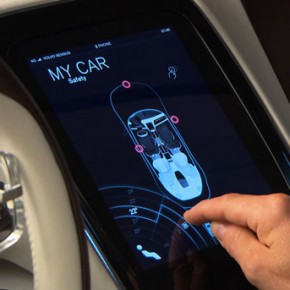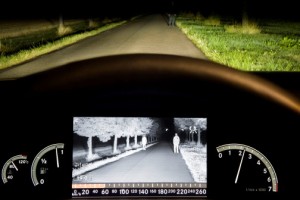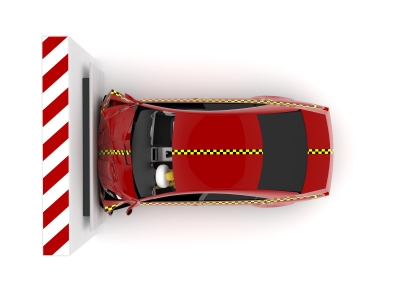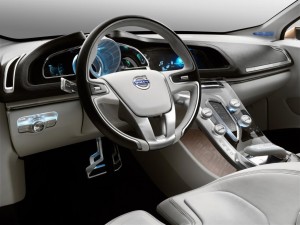One benefit to choosing a safer car is that you may save money on your auto insurance premiums. In addition to personal factors like a person’s age, gender, driving record and address, the make and model of vehicle you choose will impact your rates.
 Generally, costlier cars are more expensive to insure. Beyond that, insurance companies look at past claims histories to determine which models incur more or less damage in a crash, are more or less damaging to other vehicles, people and property, are more or less likely to be stolen and have higher or lower bodily injury claims. The latter is directly affected by how well a car protects its occupants in a crash, and its affect is typically reflected in the cost of the medical payments/personal injury protection components of an auto insurance policy.
Generally, costlier cars are more expensive to insure. Beyond that, insurance companies look at past claims histories to determine which models incur more or less damage in a crash, are more or less damaging to other vehicles, people and property, are more or less likely to be stolen and have higher or lower bodily injury claims. The latter is directly affected by how well a car protects its occupants in a crash, and its affect is typically reflected in the cost of the medical payments/personal injury protection components of an auto insurance policy.
According to State Farm, all of the vehicles among our list of safety picks can be expected to garner average or below average rates for the medical payments/personal injury coverage.
However, Jeanne M. Salvatore, a spokesperson for the Insurance Information Institute, notes that determining the cost of coverage for a given motorist and a given car is a complex process and can vary significantly from one car to another and from one insurer to another because of – and in some cases despite – a vehicle’s safety ratings.
“It always pays to call your insurance agent ahead of time to compare rates among various models you’re considering to see which will be the most affordable to insure,” she says. Salvatore advises consumers to ask about additional discounts that may be offered by equipping a car with some of the latest safety features, the best of which can prevent motorists from getting into an accident in the first place.
To that end, our list of the top Safety/Insurance Rated Cars for 2012 not only qualify as IIHS Top Safety Picks, but all either come standard with or offer as options a full array of occupant protection and accident avoidance features. (One caveat: the IIHS doesn’t rate sports cars and the most expensive luxury models, including cars like the Audi A8, BMW 7 Series and Mercedes-Benz S-Class, so they’re not represented here.)
Already, antilock brakes (which prevent a car from skidding when the brakes are applied) and stability control (to help keep a car from fishtailing out of control in sudden or emergency stopping situations) are included on every new 2012 car or truck sold in the U.S. Ford is in the process of rolling out a next-generation version of stability control called “Curve Control” that selectively applies the brakes to one or more wheels to help the driver maintain control if it senses the car has entered a curve too quickly.
One of the most valuable safety technologies to come in recent years is the Blind Spot Warning system, which is quickly becoming available on many mainstream models. It employs a set of sensors and/or cameras to detect other cars just to the side and rear of a vehicle and alerts a driver, usually with an illuminated light on the side mirrors, to their otherwise unseen presence. If the driver activates the turn signals, an audible warning will be engaged. Many blind spot warning systems further include a Cross Path Detection function that also warns motorists of traffic that’s approaching from the side when backing out of a parking space or garage.
Another high-tech safety system that’s offered on mid- to high-end vehicles is the Lane Departure Warning System. This helps keep inattentive drivers from inadvertently veering into another line of traffic and causing a collision. It looks for highway lane markings via an embedded camera and generates a signal if the vehicle is in the process of crossing them; engaging the turn signals before purposefully changing lanes temporarily deactivates the alert. A few systems can further “nudge” the car back into their lane via braking or steering intervention.
Adaptive high-intensity discharge headlamps swivel in the direction of a turn to help light the way through curves and/or automatically switch between low and high beams, based on traffic conditions.
Another advanced safety feature to look for is the Collision Warning and Avoidance system, which works with an advanced version of cruise control that uses sonar sensors to maintain both a set speed and distance from the nearest car in its path, braking automatically when traffic slows and accelerating to keep pace.
If the sensors determine if the car is closing in on the vehicle or other obstruction in its path too quickly (like when the driver isn’t paying close enough attention) and will both engage audible and visual alerts, tension the safety belts and pre-prime the brakes to full force in anticipation of an emergency stop. Some systems will actually apply the brakes if the driver isn’t reacting quickly enough to help avoid or minimize the impending collision. Volvo offers variations on this technology, called “City Safety and Pedestrian Detection,” that will automatically slam on the brakes to avoid a rear-end collision or other obstacle at slower speeds.
 Also offered, though limited to luxury cars, is Night Vision which displays an otherworldly infrared view of the road ahead beyond the headlamps’ range to help detect and alert the driver to the presence of pedestrians. What’s more, most Mercedes-Benz models now include a feature called “Attention Assist,” which monitors steering input to determine if the driver is becoming fatigued (or is otherwise impaired) and will sound an alert and illuminate a coffee cup icon on the dashboard to advise him or her to pull over and take a break.
Also offered, though limited to luxury cars, is Night Vision which displays an otherworldly infrared view of the road ahead beyond the headlamps’ range to help detect and alert the driver to the presence of pedestrians. What’s more, most Mercedes-Benz models now include a feature called “Attention Assist,” which monitors steering input to determine if the driver is becoming fatigued (or is otherwise impaired) and will sound an alert and illuminate a coffee cup icon on the dashboard to advise him or her to pull over and take a break.
What’s ahead? Nissan will be debuting so-called “around view” systems later this year that utilize small cameras and sensors that allow the car to see – and react to – what’s in front of, behind and to the sides of it. One system, called Acceleration Suppression for Pedal Misapplication can detect whether the car in a confined area like a garage and prevent the driver from inadvertently crashing into a wall or another vehicle. Another, the Multi-Sensing System with Rear Camera can perceive the presence of pedestrians and vehicles and assess road conditions to warn drivers of potential collision hazards.
Farther down the road, Toyota is reportedly developing technology that can assume control of a car’s steering to help avoid a crash if the system discerns that a collision is otherwise avoidable and the driver isn’t reacting quickly enough.
As if that’s not enough, Volkswagen is working on a system that deftly leverages the above technologies to essentially enable a vehicle to drive itself at highway speeds to prevent accidents caused by inattentive and/or distracted drivers.
While engaged, the system maintains a safe distance between the vehicle and traffic ahead via adaptive cruise control, reduces vehicle speed before entering a curve as indicated by the navigation system and keeps the car within lane markers with lane departure and electric power steering systems. It also observes passing rules and speed limits and is said to work in stop-and-go driving situations. It’s not autonomous, however, as the driver must continually monitor the system so he or she can intervene in safety-critical situations.













